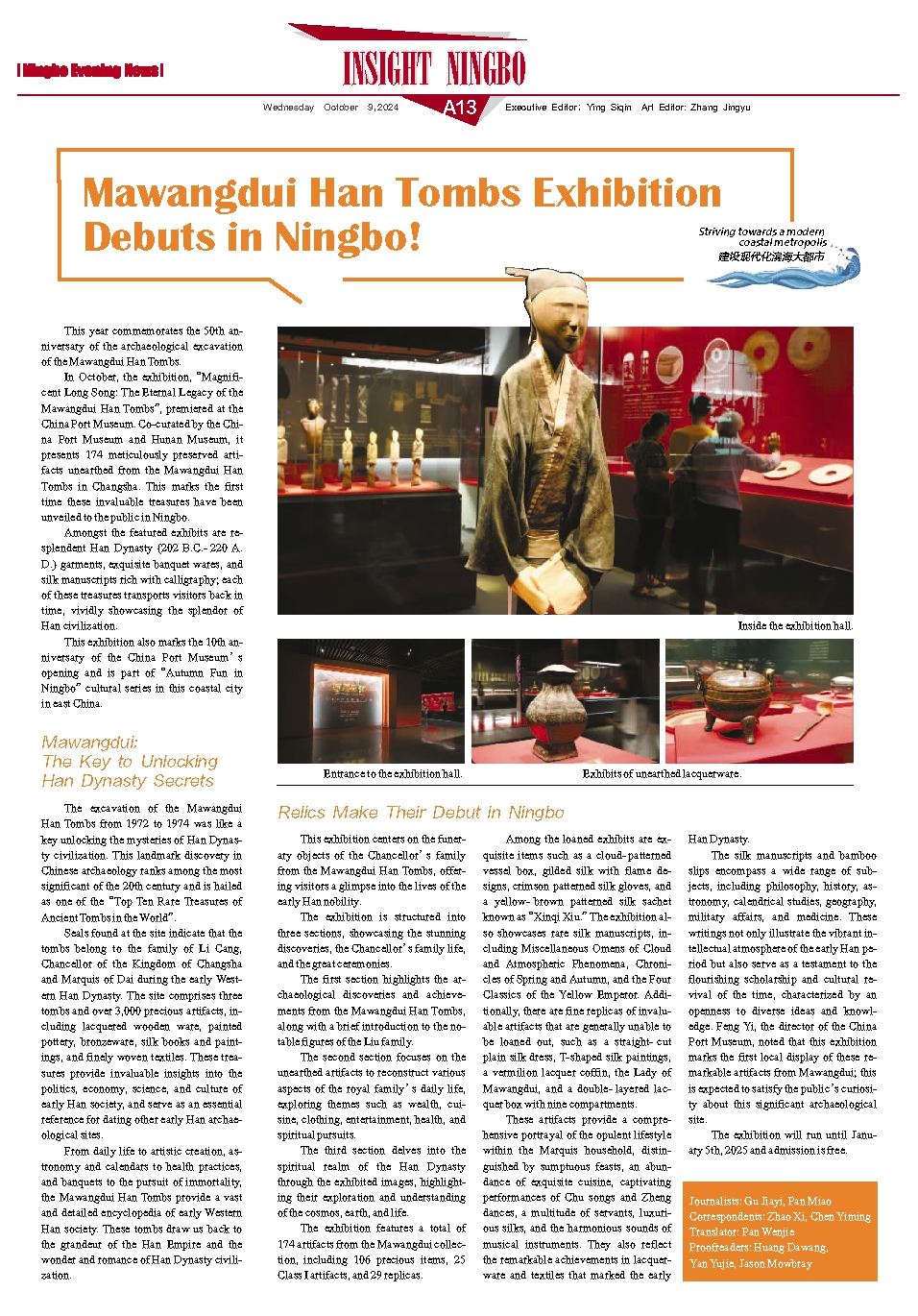This year commemorates the 50th anniversary of the archaeological excavation of the Mawangdui Han Tombs.
In October, the exhibition, “Magnificent Long Song: The Eternal Legacy of the Mawangdui Han Tombs”, premiered at the China Port Museum. Co-curated by the China Port Museum and Hunan Museum, it presents 174 meticulously preserved artifacts unearthed from the Mawangdui Han Tombs in Changsha. This marks the first time these invaluable treasures have been unveiled to the public in Ningbo.
Amongst the featured exhibits are resplendent Han Dynasty (202 B.C.-220 A.D.) garments, exquisite banquet wares, and silk manuscripts rich with calligraphy; each of these treasures transports visitors back in time, vividly showcasing the splendor of Han civilization.
This exhibition also marks the 10th anniversary of the China Port Museum’s opening and is part of “Autumn Fun in Ningbo” cultural series in this coastal city in east China.
Mawangdui:
The Key to Unlocking
Han Dynasty Secrets
The excavation of the Mawangdui Han Tombs from 1972 to 1974 was like a key unlocking the mysteries of Han Dynasty civilization. This landmark discovery in Chinese archaeology ranks among the most significant of the 20th century and is hailed as one of the “Top Ten Rare Treasures of Ancient Tombs in the World”.
Seals found at the site indicate that the tombs belong to the family of Li Cang, Chancellor of the Kingdom of Changsha and Marquis of Dai during the early Western Han Dynasty. The site comprises three tombs and over 3,000 precious artifacts, including lacquered wooden ware, painted pottery, bronzeware, silk books and paintings, and finely woven textiles. These treasures provide invaluable insights into the politics, economy, science, and culture of early Han society, and serve as an essential reference for dating other early Han archaeological sites.
From daily life to artistic creation, astronomy and calendars to health practices, and banquets to the pursuit of immortality, the Mawangdui Han Tombs provide a vast and detailed encyclopedia of early Western Han society. These tombs draw us back to the grandeur of the Han Empire and the wonder and romance of Han Dynasty civilization.
Relics Make Their Debut in Ningbo
This exhibition centers on the funerary objects of the Chancellor’s family from the Mawangdui Han Tombs, offering visitors a glimpse into the lives of the early Han nobility.
The exhibition is structured into three sections, showcasing the stunning discoveries, the Chancellor’s family life, and the great ceremonies.
The first section highlights the archaeological discoveries and achievements from the Mawangdui Han Tombs, along with a brief introduction to the notable figures of the Liu family.
The second section focuses on the unearthed artifacts to reconstruct various aspects of the royal family’s daily life, exploring themes such as wealth, cuisine, clothing, entertainment, health, and spiritual pursuits.
The third section delves into the spiritual realm of the Han Dynasty through the exhibited images, highlighting their exploration and understanding of the cosmos, earth, and life.
The exhibition features a total of 174 artifacts from the Mawangdui collection, including 106 precious items, 25 Class I artifacts, and 29 replicas.
Among the loaned exhibits are exquisite items such as a cloud-patterned vessel box, gilded silk with flame designs, crimson patterned silk gloves, and a yellow-brown patterned silk sachet known as “Xinqi Xiu.” The exhibition also showcases rare silk manuscripts, including Miscellaneous Omens of Cloud and Atmospheric Phenomena, Chronicles of Spring and Autumn, and the Four Classics of the Yellow Emperor. Additionally, there are fine replicas of invaluable artifacts that are generally unable to be loaned out, such as a straight-cut plain silk dress, T-shaped silk paintings, a vermilion lacquer coffin, the Lady of Mawangdui, and a double-layered lacquer box with nine compartments.
These artifacts provide a comprehensive portrayal of the opulent lifestyle within the Marquis household, distinguished by sumptuous feasts, an abundance of exquisite cuisine, captivating performances of Chu songs and Zheng dances, a multitude of servants, luxurious silks, and the harmonious sounds of musical instruments. They also reflect the remarkable achievements in lacquerware and textiles that marked the early Han Dynasty.
The silk manuscripts and bamboo slips encompass a wide range of subjects, including philosophy, history, astronomy, calendrical studies, geography, military affairs, and medicine. These writings not only illustrate the vibrant intellectual atmosphere of the early Han period but also serve as a testament to the flourishing scholarship and cultural revival of the time, characterized by an openness to diverse ideas and knowledge. Feng Yi, the director of the China Port Museum, noted that this exhibition marks the first local display of these remarkable artifacts from Mawangdui; this is expected to satisfy the public’s curiosity about this significant archaeological site.
The exhibition will run until January 5th, 2025 and admission is free.
Journalists: Gu Jiayi, Pan Miao
Correspondents: Zhao Xi, Chen Yiming
Translator: Pan Wenjie
Proofreaders: Huang Dawang,
Yan Yujie, Jason Mowbray






